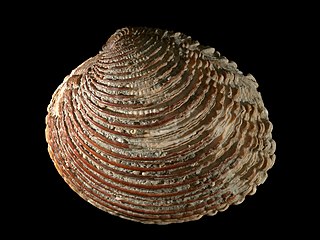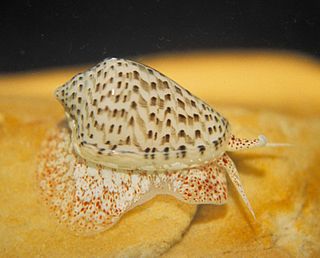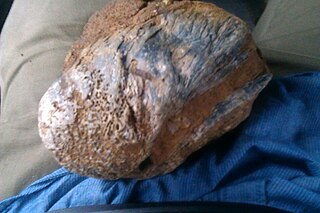
Gryphaea, one of the genera known as devil's toenails, is a genus of extinct oysters, marine bivalve mollusks in the family Gryphaeidae.

The Ostreidae, the true oysters, include most species of molluscs commonly consumed as oysters. Pearl oysters are not true oysters, and belong to the order Pteriida.

The Veneridae or venerids, common name: Venus clams, are a very large family of minute to large, saltwater clams, marine bivalve molluscs. Over 500 living species of venerid bivalves are known, most of which are edible, and many of which are exploited as food sources.

Ostrea is a genus of edible oysters, marine bivalve mollusks in the family Ostreidae, the oysters.

Rapaninae is a subfamily of predatory sea snails, marine gastropod mollusks in the family Muricidae.

Tulip snail or tulip shell is the common name for eight species of large, predatory, subtropical and tropical sea snails from the Western Atlantic. These species are in the genus Fasciolaria. They are marine gastropod mollusks in the family Fasciolariidae, the spindle shells, tulip shells and their allies.

Marginellidae, or the margin shells, are a taxonomic family of small, often colorful, sea snails, marine gastropod molluscs in the clade Neogastropoda.

Xenophora, commonly called carrier shells, is a genus of medium-sized to large sea snails, marine gastropod mollusks in the family Xenophoridae, the carrier snails or carrier shells. The genus Xenophora is the type genus of the family Xenophoridae.

The Plicatulidae are a family of saltwater clams, marine bivalve mollusks, known commonly as kitten's paws or kittenpaws. These bivalves are related to oysters and scallops. The family has a single living genus, Plicatula, with a second, Harpax known from fossils.

Exogyra is an extinct genus of fossil marine oysters in the family Gryphaeidae, the foam oysters or honeycomb oysters. These bivalves were cemented by the more cupped left valve. The right valve is flatter, and the beak is curved to one side. Exogyra lived on solid substrates in warm seas during the Jurassic and Cretaceous periods.

The giant honeycomb oyster is a very large saltwater oyster, a marine bivalve mollusk.

Pycnodonte is a genus of extinct oysters, fossil marine bivalve mollusks in the family Gryphaeidae, the foam oysters or honeycomb oysters. Shells of species in this genus are found around the world in fossil shell beds from the Valanginian to the Early Pleistocene. They are a commonly found fossil in Cretaceous shellbeds of the Navesink Formation in New Jersey.

Conus caracteristicus, common name the characteristic cone, is a species of sea snail, a marine gastropod mollusk in the family Conidae, the cone snails and their allies.

Hyotissa is a genus of large saltwater oysters, marine bivalve mollusks in the family Gryphaeidae.
Hyotissa mcgintyi, also known as Parahyotissa mcgintyi, is a species of medium-sized saltwater "oyster", a marine bivalve mollusk in the family Gryphaeidae. This species occurs in the western Atlantic Ocean. Species in this genus are known as "honeycomb oysters" or "foam oysters" because under magnification, the majority of their shell structure is characteristically foam-like.

Aetostreon is an extinct genus or subgenus within the genus Exogyra of fossil marine oysters in the family Gryphaeidae.

Hyotissa semiplana is an extinct species of large saltwater oysters, a fossil marine bivalve mollusk in the family Gryphaeidae, the foam oysters

Neopycnodonte is a genus of marine bivalve molluscs belonging to the family Gryphaeidae.
Liostrea is a genus of extinct oysters, marine bivalve mollusks in the family Gryphaeidae.



















